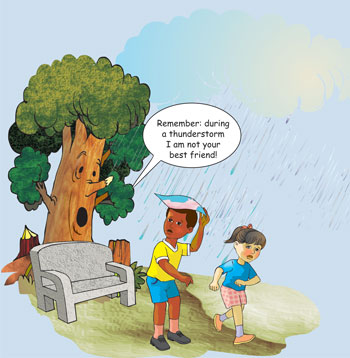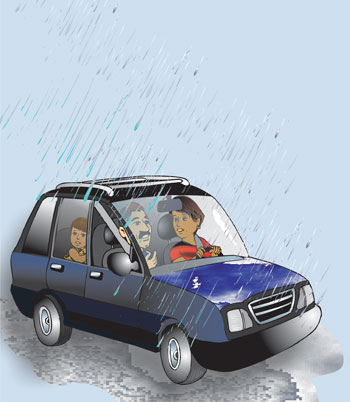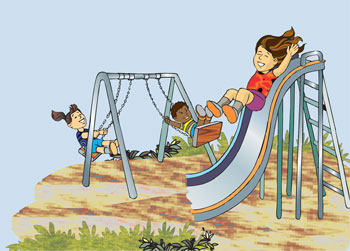|
Lightning
 The
World Meteorological Organization (WMO)’s International Meteorological
Vocabulary describes lightning as an electrical discharge between a cloud
and the ground. It follows an irregular but well defined and frequently
forked path. The
World Meteorological Organization (WMO)’s International Meteorological
Vocabulary describes lightning as an electrical discharge between a cloud
and the ground. It follows an irregular but well defined and frequently
forked path.
Lightning occurs during thunderstorms, and is accompanied, as the name
implies, by thunderclaps as well as strong winds and sometimes hail or
even tornados.
Signs that a lightning
storm may be approaching
- Strong winds.
- Heavy rainfall.
- Dark clouds.
Part I – Reminders
- A large number
of victims are hit by thunderstorms, but over 50% the deaths by lightning
take place after the storm has apparently finished.
- It is advisable
to remain indoors for at least 30 minutes after the last thunderclap.
- If there are thunderstorms
nearby but not in the immediate vicinity, you may still be struck by
lightning even if the sky is clear.
Advice for when
there is lightning
- If a storm is approaching,
stay away from high places, hill and mountain tops, open fields, isolated
trees, picnic areas, grain silos, sheds and windmills. Avoid riding
in convertible cars, golf-carts, and sailboats, and stay away from communications
towers and power lines.
- If you are riding
a solid-roof (non-convertible) car or truck, it is better to remain
inside the vehicle.
- The reason you
should stay away from sailboats is because masts attract lightning.
- If you can see
lightning or hear thunder, you are at risk.
- If the thunder
is getting louder or more frequent, the storm is approaching, increasing
the risk of injuries or fatalities.
- If the time elapsed
between the sight of lightning and the sound of thunder is 30 seconds
or less, you are in danger.
- Large enclosed
spaces are safer than small or open spaces.
- If you are indoors,
do not take a shower, use the telephone or touch conductive surfaces
such as metallic doors or window frames.
- In a car, keeping
the windows rolled up protects you from lightning. Try not to touch
the metallic parts of the vehicle.
- During a thunderstorm,
do not use electrical appliances such as hair dryers, irons, television
sets or electric shavers.
 What
to do if someone is hit by lightning? What
to do if someone is hit by lightning?
- About 90% of people
hit by lightning survive, especially if medical care is provided quickly.
- People hit by
lightning do NOT carry and electric charge, so they can be handled and
given medical care. Immediately after calling the doctor or an ambulance,
begin mouth-to-mouth resuscitation. If the victim does not have a pulse,
cardiopulmonary resuscitation (CPR) should be carried out immediately.
Part II –
To bear in mind
- The air near lightning
is heated to a temperature of approximately 27,000 degrees Celsius!
- A lightning strike
can generate between 100 million and one billion volts of electricity.
- Every storm involves
lightning; thunderstorms occur about 20 million times a year worldwide.
- Thunderstorms
occur most frequently in spring and summer during the afternoon and
evening, but they can occur at any time of the day or night, year-round.
- A significant
number of fires are started by thunderstorms.
- Many people have
died from lightning when they were sailing, swimming, playing golf,
riding a bicycle, horse riding, playing football, fishing, mountain
climbing or standing under a tree.
 Myths
and facts about thunderstorms Myths
and facts about thunderstorms
Myth: If it is not
raining, lightning does not pose a threat.
Fact: Lightning can strike as far away as 15 Km from any rainfall.
Myth: Wearing rubber soles protects you from lightning.
Fact: Rubber soles provide no protection. Rubber tires are no help either,
although it is safer to remain inside a car during a storm than going
outdoors. You should try not to touch any metal surfaces, though.
Myth: People hit by lightning carry an electrical charge and should not
be touched.
Fact: Lightning victims do not carry an electrical charge, and they should
be cared for immediately.
What is Mr. Weather’s
advice in the event of a thunderstorm?
- Stop your games
or other activities.
- If you see a storm
approaching, head towards a building or car.
- Stay away from
trees, towers, street lights and power lines.
- If you’re
swimming or sailing, head for shore.
- Practice a crouching
posture for when you are outdoors and have no shelter in sight. Remember
to remain on tip-toe.
Adapted from Jaquelina
Michienzi, The Weather Channel
Jaquelina Michienzi was an aeronautical meteorologist at the Argentinean
Air Force from 1983 to 1996. Since 1997, she has worked as a senior meteorologist
at the Weather Channel.
Sources:
National Oceanic and Atmospheric Administration (NOAA), Federal Emergency
Management Agency (FEMA) and American Red Cross (ARC), Thunderstorms,
Tornados, Lightning.
NOAA. Avoiding the
risk of deadly lightning strikes. A NOAA Backgrounder.
National Meteorological Service (SMN) of Argentina. Rayos y Tormentas.
SMN Bulletin.
Argentinean Red Cross. Cuadernillo de primeros auxilios.
|




